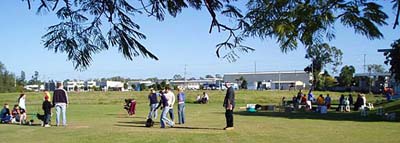Many trainers still use traditional correction methods of training, while others have changed over to - or have entirely grown up with the newer techniques. Training schools offer three options: live-in training, individual lessons or group classes.
a. Live-in Kennels
Dogs are sent away as boarders for several weeks and are 'obedience' trained every day, by somebody else. Usually they live in concrete kennels housing several other dogs and are usually trained with traditional methods. At the end of the course, before the dog goes home, the owners are shown the 'commands' and how to enforce discipline and correct the dog for disobedience.
C.L.E.A.R Dog Training does not advocate or provide this type of training.
b. Individual lessons
At C.L.E.A.R Dog Training individual attention is given to the relationship between you and your dog in your own home. Often this relationship is out of balance, with a dog in charge! Lessons usually run for an hour and a half to two hours.
An experienced instructor will observe how you and your family communicate and how well your dog understands you. He or she will find out what your goals are and what new behaviours you want your dog to learn - or what current behaviours you would like to modify.
You will be shown how to teach your dog basic control ('obedience') with hand signals first and then by voice. As there are no disruptions, you and your dog can concentrate, learn faster and achieve your goals sooner. Weekly training plans are made available should you wish to practice - highly recommended! - in between lessons.
c. Group Classes

At C.L.E.A.R Dog Training
Sunday afternoon beginner's class 2004
From 2001 - 2012 C.L.E.A.R ran group classes at our training venues around Brisbane. Over 6,000 people, including breeders, vets and other dog trainers, came to them from all over South East Queensland. However, as of mid 2012 we no longer run group classes as have found that in-home training is more beneficial for most time-challenged owners.
Knowing how to 'sit' in the kitchen before a meal is an excellent and necessary first step. However, it is a quite different behaviour to 'sitting' for five seconds with several other dogs nearby! Sitting before crossing a road, or sitting for one minute on wet grass at a competition, or - more usefully perhaps - sitting automatically and politely to greet people at the front door are again totally new behaviours.
This process is much easier for them if their owners have already acquired a basic understanding of dog behaviour, how dogs learn and how best to teach new behaviours.
At group classes there will be obvious distractions, but attending a good dog club with competent instructors attuned to what is happening and with owners who have been shown how to read accurately their dog's body language, controlled socialisation provides an excellent learning opportunity. A dog will put into practice what s/he has already learned in a quiet home environment and the desired behaviours will become more reliable.
Training Goals
The aims of all animal trainers are similar: to eliminate existing undesired behaviours or to establish new ones and have their animal instantly perform desired behaviours on request. Some people unfortunately go to great lengths to belittle other trainers or other training techniques and claim that they and their unique method is the only one that works. The simple fact is that results can, without question, be achieved with all training methods.
It is the approach to learning, the enjoyment or otherwise of the training process and the philosophy and vocabulary that are different. 'Command' and 'obedience' become 'cue' and 'good manners', while 'correct' and 'dominate' change to 'show' and 'motivate'.
Traditional trainers - whether of porpoises, pigs, horses, parrots or dogs - instantly correct and punish mistakes whereas positive reinforcement and clicker trainers welcome them as a learning opportunity. They ignore errors and concentrate on setting an animal up for success and helping it to improve, step by step, on what it can do right.
Many zoos worldwide have changed to positive reinforcement techniques. They no longer have to use force or sedate their elephants and other exotic animals when clipping toenails, giving injections or collecting blood.
The polar bears at Sea World on Queensland's Gold Coast quickly learned a range of behaviours from the head marine mammal trainer, Kerrie Haynes-Lovell: sit, lie down, station (for weighing), present paw, mouth open, teeth clean, and 'shift' - to move from one place to another. No force was ever involved and they were trained with a marker signal, and an occasional reward, to follow a target stick.
[For many years Kerrie has been a lecturer at the Delta Society Australia's Canine Good Citizen Level IV instructor's course. She has helped and mentored hundreds of trainers in Australasia who share her belief that positive reinforcement training works as equally well for dogs and donkeys as it does for dolphins, killer whales or her beloved polar bears.]
"Geordie" from the Dog Squad on the Sunshine Coast, whose owner was influenced by Kerrie Haynes-Lovell's techniques, easily won the Australian/New Zealand Police Dog Championships. Clicker trained dogs, like "Spinner" and "Kiri", are obtaining spectacular results at obedience and agility competitions around Australia. Service and mobility assistance dogs in many countries are increasingly being trained with positive reinforcement + a clicker.
"Peek", a 3. 5-kilo Papillon, is an assistance dog for a double leg amputee in a wheelchair. He can put clothes into a washing machine, make the bed, fetch the phone and TV remote controls, open and shut cupboard doors, flush the lavatory, tug clothing off his owners body, and activate power door openers,push buttons in a lift (below) and operate light switches.
His owner/trainer Debi Davis from Tucson, Arizona, says, "Peek was close to euthanasia when he came into my life at 3 months, with a host of behavioural problems."
So she joined a traditional training class where, "the more I pushed, pulled and corrected the more Peek postured, growled and challenged. Classes were a war of wills. He hated wearing the check chain and hid when I tried to put it on him." They both found it "too stressful" and when she was told to use an ear pinch to teach holding the dumbbell Debi finally quit.
Soon afterwards she discovered a clicker class that accepted small dogs for service work. A few years later, after thousands of "short, happy, proactive learning sessions", Peek became the first 'toy' breed to win the prestigious 'Service Dog of the Year' Award at the 1999 Delta Society annual conference. He was also the first 'clicker-trained' dog ever to do so.
However, most dog owners just want an ordinary 'family dog' that behaves properly inside the house, is safe around children and doesn't jump up on visitors or pull or lunge and bark frantically at other dogs when out for a walk. By using these same training methods many people have dogs that are fun, polite and can be taken anywhere.
These owners have found that the new ways are just as effective, if not much more so, than training with force, compulsion or fear. They have also found them very much more efficient, easy and enjoyable - at both ends of the lead. They have welcomed the accelerated learning that comes when their dogs have learned quickly because they WANT TO - not because they HAVE TO!


